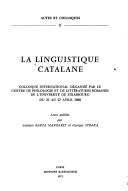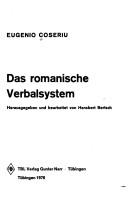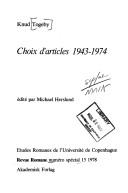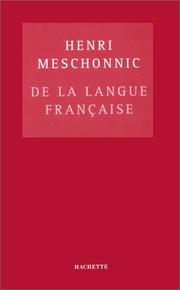| Listing 1 - 10 of 235 | << page >> |
Sort by
|
Book
ISBN: 9783110313437 311031343X 3110313502 3110394871 9783110313505 Year: 2016 Volume: volume 12 Publisher: Berlin: Walter de Gruyter,
Abstract | Keywords | Export | Availability | Bookmark
 Loading...
Loading...Choose an application
- Reference Manager
- EndNote
- RefWorks (Direct export to RefWorks)
La langue de spécialité se définit soit par les contenus spécialisés qu'elle exprime, soit par un sous-système qui vient s'ajouter au système non-marqué. En effet, chaque domaine spécialisé exige, tout naturellement, une création terminologique propre. En plus, les traditions discursives divergent d'un domaine spécialisé à l'autre. L'expression spécialisée est condamnée à obéir à ces deux contraintes. Le terme de «langue de spécialité» désigne en même temps un style de langue; sans différencier entre les spécialités, celui-ci s'oppose aux autres styles par l'application additionnelle de certains types d'élaboration syntaxique; cette observation s'inscrit en faux contre l'habituel diagnostic d'une syntaxe défective. Une étude fréquentielle prouve le bien-fondé de l'analyse. L'emploi de ce sous-système est fort expansif également en dehors des langues romanes.
Romance languages --- Sublanguage. --- Variation. --- Technical Romance. --- Scientific Romance languages --- Technical Romance languages --- Language for special purpose --- Scientific Romance --- Technical Romance --- Variation --- Romance languages - Scientific Romance --- Romance languages - Technical Romance --- Romance languages - Variation --- French language --- Jargon --- Phonology --- Jargon. --- Phonology.
Book
ISBN: 1589016513 1441612041 9781441612045 9781589016514 9781589012134 1589012135 Year: 2008 Publisher: Washington, D.C. : Georgetown University Press,
Abstract | Keywords | Export | Availability | Bookmark
 Loading...
Loading...Choose an application
- Reference Manager
- EndNote
- RefWorks (Direct export to RefWorks)
Thirty-three million people in the United States speak some variety of Spanish, making it the second most used language in the country. Some of these people are recent immigrants from many different countries who have brought with them the linguistic traits of their homelands, while others come from families who have lived in this country for hundreds of years. John M. Lipski traces the importance of the Spanish language in the United States and presents an overview of the major varieties of Spanish that are spoken there. Varieties of Spanish in the United States providesùin a single volumeùus
Spanish language --- Castilian language --- Romance languages --- Bilingualism

ISBN: 2252014806 9782252014806 Year: 1973 Volume: 11 Publisher: Paris: Klincksieck,
Abstract | Keywords | Export | Availability | Bookmark
 Loading...
Loading...Choose an application
- Reference Manager
- EndNote
- RefWorks (Direct export to RefWorks)
Catalan language --- Catalan (Langue) --- Congresses --- -Romance languages --- Congresses. --- -Congresses --- Romance languages --- Catalan language - Congresses --- Catalan (langue) --- Linguistique --- Espagne --- Catalogne (espagne)

ISBN: 3878080662 9783878080664 Year: 1976 Volume: 66 Publisher: Tübingen: Narr,
Abstract | Keywords | Export | Availability | Bookmark
 Loading...
Loading...Choose an application
- Reference Manager
- EndNote
- RefWorks (Direct export to RefWorks)
Romance languages --- Grammar --- Langues romanes --- Verb --- Verbe --- -Neo-Latin languages --- Italic languages and dialects --- Verb. --- -Verb --- Romance languages - Verb
Book
ISBN: 9781107036185 9781139566391 1107036186 9781108718929 1108718922 131639171X 1316390918 1316392112 1316392317 1316391914 1316391515 1139566393 1316389707 Year: 2015 Publisher: Cambridge: Cambridge university press,
Abstract | Keywords | Export | Availability | Bookmark
 Loading...
Loading...Choose an application
- Reference Manager
- EndNote
- RefWorks (Direct export to RefWorks)
"One of the most remarkable features of phonation is the disruption of the normal respiratory cycle. Indeed, outside phonation, the normal cycle of respiration presents a comparable duration for both the inspiration and the expiration (top of Figure 1.1). Figure 1.1 Respiration cycle, without phonation (top) and with phonation (bottom) The first produced prosodic units are breath groups. At early stages of language learning, children mainly use the necessary silent pause in the inspiration phase of their respiratory cycle as boundary markers of these units. The phonation process results from the air flow generated by the lung compression during the respiration-expiration phase. This air flow generates the necessary subglottal pressure needed to produce the vibration of the vocal folds for voiced sounds (vowels, voiced consonants), friction for fricative consonants, and intraoral pressure to allow the production of stop consonants"-- "Using an innovative approach, this book focuses on a widely debated area of phonetics and phonology: intonation, and specifically its relation to metrics, its interface with syntax, and whether it can be attributed more to phonetics or phonology, or equally to both. Drawing on data from six Romance languages (French, Italian, Spanish, Portuguese, Catalan and Romanian), whose rich intonation patterns have long been of interest to linguists, J-Philippe Martin challenges the assumptions of traditional phonological approaches, and re-evaluates the data in favour of a new usage-based model of intonation. He proposes a unified description of the sentence prosodic structure, focusing on the dynamic and cognitive aspects of both production and perception of intonation in speech, leading to a unified grammar of Romance languages' sentence intonation. This book will be welcomed by researchers and advanced students in phonetics and phonology"--
Romance languages --- Intonation (Phonetics) --- Biolinguistics --- Phonetics --- Intonation --- Phonology --- Phonology, Historical --- Spoken Romance languages --- Prosodie. --- Romanische Sprachen. --- Sprachproduktion. --- Biolinguistics. --- Biology --- Linguistics --- Grammar, Comparative and general --- Language and languages --- Pitch (Phonetics) --- Prosodic analysis (Linguistics) --- Tone (Phonetics) --- Oral interpretation --- Neo-Latin languages --- Italic languages and dialects --- Intonation. --- Phonology. --- Phonology, Historical. --- Spoken Romance languages. --- Romance languages - Phonetics - Intonation --- Romance languages - Phonology --- Romance languages - Phonology, Historical --- Romance languages - Spoken Romance languages
Book
ISBN: 2801112275 9782801112274 Year: 1999 Volume: *5 Publisher: Louvain-la-Neuve: Duculot,
Abstract | Keywords | Export | Availability | Bookmark
 Loading...
Loading...Choose an application
- Reference Manager
- EndNote
- RefWorks (Direct export to RefWorks)
Romance languages --- Langues romanes --- Romaanse talen --- History --- Histoire --- Linguistique romane --- --Langue française --- --Langues romanes --- --Histoire --- --Romance languages --- Handbooks, manuals, etc. --- Langue française --- 804 --- 804 Romaanse taalkunde --- Romaanse taalkunde
Book
ISBN: 9783110302080 311030208X 3110302225 3110394138 3110302217 9783110302219 Year: 2015 Volume: 8 8 8 8 Publisher: Berlin: Walter de Gruyter,
Abstract | Keywords | Export | Availability | Bookmark
 Loading...
Loading...Choose an application
- Reference Manager
- EndNote
- RefWorks (Direct export to RefWorks)
The Manuel de linguistique française provides a concise, critical overview of the historical foundations and the current situation of the French language and introduces its readers to the most important topics and questions of present-day linguistic research on French. Compared with other reference works currently available on the market, this manual provides a lot of additional and updated information.
French language --- Langue d'oïl --- E-books --- French language. --- Romance languages

ISBN: 8750018604 9788750018605 Year: 1978 Volume: 15 Publisher: Copenhagen: Akademisk Forlag,
Abstract | Keywords | Export | Availability | Bookmark
 Loading...
Loading...Choose an application
- Reference Manager
- EndNote
- RefWorks (Direct export to RefWorks)
Old French literature --- Romance languages --- French philology --- Langues romanes --- Philologie francaise

ISBN: 201235193X 9782012351936 Year: 1997 Publisher: Paris: Hachette,
Abstract | Keywords | Export | Availability | Bookmark
 Loading...
Loading...Choose an application
- Reference Manager
- EndNote
- RefWorks (Direct export to RefWorks)
French language. --- Français (Langue) --- French language --- Langue d'oïl --- Romance languages --- Français (Langue)
Book
ISBN: 8476351615 9788476351611 Year: 1997 Publisher: Madrid: Arco/Libros,
Abstract | Keywords | Export | Availability | Bookmark
 Loading...
Loading...Choose an application
- Reference Manager
- EndNote
- RefWorks (Direct export to RefWorks)
Spanish language --- Comparison. --- #KVHA:Linguistiek; Spaans --- Castilian language --- Romance languages --- Comparison --- Grammar --- Spanish language - Comparison.
| Listing 1 - 10 of 235 | << page >> |
Sort by
|

 Search
Search Feedback
Feedback About UniCat
About UniCat  Help
Help News
News